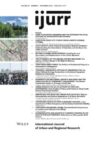Historical and cultural studies of residential enclaves reveal the range of patterns within a phenomenon that some have treated essentially as the result of contemporary neoliberal conditions. Gated and enclosed communities are by no means new, nor are they the product of universal principles or circumstances. Among other things, they reflect historical conditions, contemporary concerns, cultural ambitions and inter‐group dynamics. Based largely on comparisons of national inventories of gated communities in Israel and Canada, this article explores some of the articulations and functions of enclosure. It illuminates the contrasts within a set of historic and contemporary enclosed and segregated settlements, and seeks to develop a framework to account for the range of patterns found and some of the motivations behind them. While many enclaves in Israel feature extensive security measures that include armed guards, Canadian gated communities typically use weak devices such as low fences. The patterns employed to mark difference reinforce divergent social conditions and generate varying spatial consequences. The comparison reveals variations in who produces enclosure, how, and for what purposes.
Details
Written by:
GILLAD ROSEN, JILL GRANT
Digital Object Identifier (DOI)
10.1111/j.1468-2427.2010.00981.x
About DOI
Read full article as PDF
Read full article as HTML
See the references for this article
